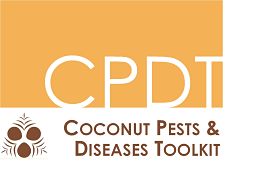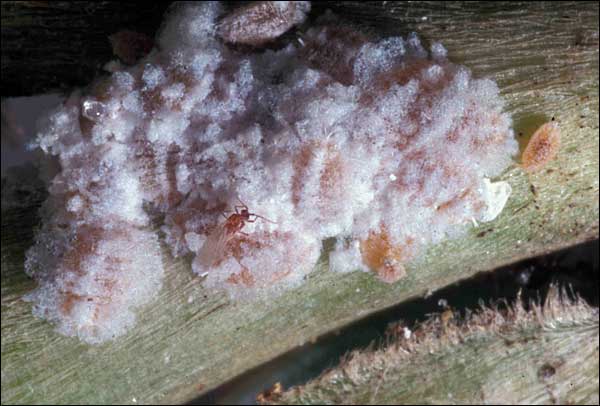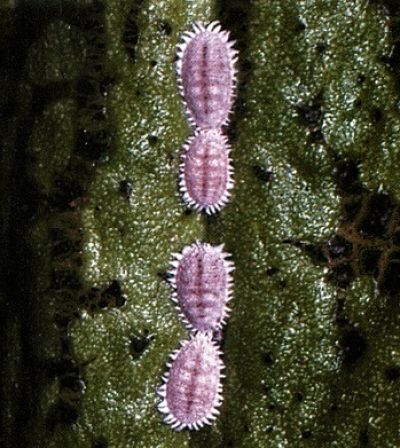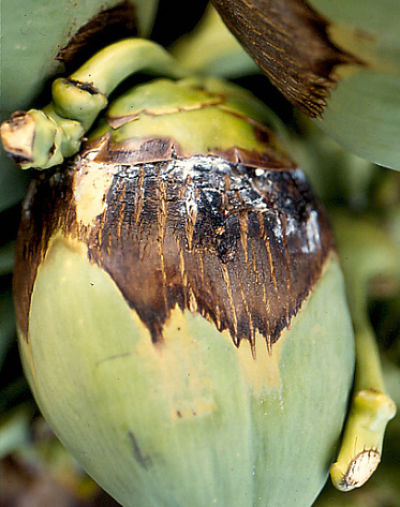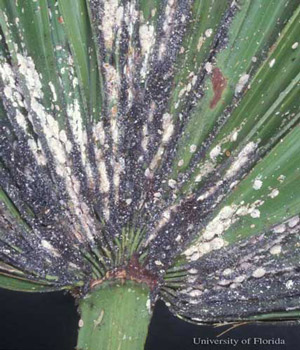Mealybug - cacao
Cacao mealybug is a serious pest of coconut and other economically important crops. There is a high risk of outbreak under certain conditions.
Common nameCacao mealybug |
Scientific namePlanococcus lilacinus |
on this page: Life-cycle and identification : Symptoms : Impacts : Distribution : Prevention : Controlling cacao mealybug : Information sources and further reading
Life-cycle and identification
|
Mealybugs are a diverse group of sap-sucking insects that feed on plants. The female Cacao mealybug is is oval in shape, up to 5 mm long, and is covered in powdery white wax secretions. Combined with the underlying body colour the overall appearance may be pale mauve (a light purple - pink). There is usually a slightly darker line down the centre of the back, and 18 waxy filaments (clumps) protruding from each side. The winged adult male and wingless female are very different in appearance. The the sexes are less distinct in the immature stages. Adult females and the mostly immobile nymphs form dense colonies on a wide range of host plant species. Sugary honeydew produced by the mealybugs attracts ants. These ants feed on the sugar and protect the mealybugs from natural enemies. This results in larger mealybug populations and more honeydew production. |
Colony of woolly looking mealybugs. These are not Cacao mealybugs. Nymphs, female adults and one winged adult male are visible (© Takumasa (Demian) Kondo, idtools.org) |
Young nymphs (crawlers) : Adults
Young nymphs (crawlers)After mating and the development of eggs, females give birth to live 'crawlers’ (first-instar nymphs). Initially, these crawlers settle on the underside of palm parts to hide from sunlight and predators. Young mealybugs later disperse to other feeding sites. The nymphs take 1-2 months to develop into adults before mating. Male adults and nymphsAdult males have wings (see centre of image on the right), and are around 1 mm long with prominent legs and antennae. As the males do not feed they live only a few days. Immature males are creamy white-yellow. The immature males secrete a very small, fuzzy white cocoon, inside which they develop. The adult males fly about looking for females to mate with. Female adults and nymphsThe body colour of the female under the waxy layer can help identify the life stage. |
Young, maroon (dark red) coloured, female mealybugs (© Peter A.C. Ooi, UTAR) |
In older nymphs and young adult females the body contents are maroon (dark red).
When fully mature, the wingless adult females change colour to tan or brown-red and may be up to 5 mm long.
Female cacao mealybugs live for several months, mostly staying in the same place, and only rarely moving from the colony
SymptomsCacao mealybug can severely damage coconuts. Sap extraction by nymphs and adults can damage all palm growth stages. Sap extraction by a heavy mealybug infestation can cause the whole crown to wilt and look shrivelled. Inflorescences (the whole flower head) and tips of the leaves may dry out, and the growing point may start to die back. Leaves may also show a few spots of damage, become yellow and eventually fall off. If the infestation spreads to the fruits and stem, the stem tissue may look diseased and dead. Look for early fruit drop, button shedding, and fruit that is distorted and discoloured, with surface scarring and an irregular texture (image on the right). More specific symptoms include sticky honeydew deposits and/or sooty mould growths on the leaves and stems (see image below right). This is caused by honeydew excretions by high density colonies feeding on the leaves and stems. Ants may also be present as they are attracted to the increase of honeydew excretions. The ants protect the mealybug colonies from predators and parasites, and make the mealybug problem worse. ImpactsCacao mealybug damage can significantly reduce crop yields. Fruit damaged by mealybug feeding may be rejected by markets or have reduced market value. Economic losses from button shedding alone can range from 10 to 20% of the crop. DistributionCacao mealybug is found in the tropics and warm subtropics almost worldwide. In the Pacific Ocean region cacao mealybug has been recorded in Bangladesh, Brunei, Cambodia, Federated States of Micronesia, Guam, Indonesia, Japan, Laos, Malaysia, Maldives, Northern Mariana Islands, Papua New Guinea, Philippines, Sri Lanka, Thailand and Vietnam. Please check with your local biosecurity / quarantine or SPC for up-to-date distribution information. |
Scarring and discolouration to coconut from mealybug feeding and honeydew excretions (© Scot Nelson, Flickr)
Sooty mould growth from honeydew secretions, surrounding mealybug colonies at the base of a frond (© Lyle J. Buss, University of Florida) |
Prevention
Most importantly, the International Guidelines for transfer of coconut germplasm should be strictly followed to prevent pests and diseases being moved to new locations.
The waxy coating of mealybugs, and their habit of living on the undersides of plants, protects them from contact with insecticide sprays. The crawlers are the developmental stage most vulnerable to insecticides and heavy rain mortality.
Use of broad-spectrum pesticides may reduce natural enemy populations without killing the mealybugs, allowing an outbreak to develop. For that reason this type of pesticide use should be avoided.
Uncontrolled ant populations, especially of introduced invasive ant species, may increase the protection of mealybugs. Ants sometimes help to disperse mealybugs too. This enables the mealybugs to spread, multiply and cause further damage.
Detection and field identification of cacao mealybug (as distinct from other mealybug species) may be difficult, especially within dense palm plantings. Mis-identification can result in the wrong control method being used, or they may left untreated.
If mealybugs are accidentally introduced into areas without their usual natural enemies then outbreaks are likely to occur and cause widespread damage.
Detecting infestations early is important when controlling mealybugs. Palms should be checked regularly for mealybug colonies. Look under leaves, in the junctions of leaves and stems and on new growth for crawlers. Additionally, look for colonies of adults on the fruits, stems and near leaf veins..
For general information on preventing pests and diseases of coconut, see the Prevention section.
Controlling cacao mealybug
We strongly recommend an integrated pest management (IPM) approach to the control of all insects, where possible. This is a combination of methods (pesticides, physical controls such as site hygiene, and biological controls) to minimise the use of pesticides and their negative impact on natural enemy populations, and minimise the cost of control.
Integrated Pest Management (IPM)
The goal of IPM is to keep pest populations to a level below which they cause economic harm. IPM involves using multiple control options together for the economic control of pests (i.e. cultural, natural and chemical).
In an agricultural context the Food and Agriculture Organization defines IPM as "the careful consideration of all available pest control techniques and subsequent integration of appropriate measures that discourage the development of pest populations and keep pesticides and other interventions to levels that are economically justified and reduce or minimize risks to human health and the environment. IPM emphasizes the growth of a healthy crop with the least possible disruption to agro-ecosystems and encourages natural pest control mechanisms".
Cultural
- Rub or pick the mealybugs from the palm part to remove the colony.
- Trimming and destroying infested parts is also recommended. Do not leave infested trimmings lying in the plantation, where they can be a source of re-infestation.
- If the damage is considerable, remove and destroy the palm to stop it sourcing an outbreak.
- A high pressure water jet may be used to blast mealybug colonies off, onto the ground. Return to the palm canopy will be too demanding on the insects and predators have increased access to them on the ground. Be aware of ants protecting colonies, as they may carry them back up the palm.
Make sure the soil quality is high, as this keeps the palm healthy so it can survive infestations. Good soil also improves the environment for natural predators to flourish and keep mealybugs at bay.
Capturing adult males has also been beneficial in reducing mealybug populations. A simple tool is to put yellow sticky tape traps up to catch and monitor the mobile males. Follow the recommended guidelines for hanging the traps to reduce the chances of catching natural enemies of mealybugs. These can be purchased from Bugs for Bugs in Australia, and there may be other sources in the Pacific.
Regularly check palms for symptoms, especially honeydew deposits, sooty mould growth and ants tending the mealybugs. If you think you have a significant infestation of mealybugs, you should report it to your local department of agriculture who can carry out the right procedures and correctly identify the insect.
Natural
A natural predator of cacao mealybugs is the mealybug destroyer lady beetle (Cryptolaemus montrouzieri) which has been successful in exclusively feeding on large colonies of mealybugs. The eggs of the lady beetle are laid in the tightly packed mealybug colonies to hatch and feed on them alongside the adults. The mealybug destroyer can be purchased from Bugs for Bugs in Australia.
Leptomastix dactylopii, a parasitic wasp, has also been observed controlling the cacao mealybug. However, it prefers the citrus mealybug (Planococcus citri) as a host.
The control of ants should be considered. This can be done by finding and destroying the ant nest or placing barriers around the trunk and stems. However, ants may be a predator to many other pest insects so removal should be carefully considered.
On balance local removal of ant nests is probably a good idea around individual palms, especially if it can be done without using pesticides. More information and advice on getting rid of ants can be found on the Pacific Invasive Ant Toolkit.
Chemical
Pesticides are commonly used on mealybugs, but should be considered a last resort because their waxy coating protects them from contact with aqueous sprays..
Botanical insecticides such as Neem Oil 3%, 25g/litre of fish oil rosin soap or other insecticidal soaps can be sprayed on crawlers and colonies when infestation is not at a high density. These products can be brought or homemade.
When mealybugs are at high numbers, it is possible to use either:
- 2 ml/litre of Buprofezin, or
- 0.6 ml/litre of Imidacloprid, or
- 0.6g/litre of Thiamethoxam.
Although chlorpyriphos, dimethoate and profenophos (organophosphates) are sometimes advised for the control of mealybugs, many countries have banned the use of organophosphates. We do not recommend their use.
Imidacloprid and thiamethoxam have also been implicated in the decline of honey bees and other pollinators. We strongly discourage the use of these types of insecticides around insect-pollinated crops
Care should be taken when using pesticides and other chemicals to reduce the number of natural enemies being killed. Use spot application only, and avoid broad-spectrum pesticides.
The Pacific Invasive Ant Toolkit discusses considerations around pesticide use, and the types of insecticides commonly used: insect growth regulators, and neurotoxins and stomach poisons.
Information sources and further reading
Bugwoodwiki. 2013. Planococcus lilacinus. [ONLINE]
CABI. 2018. Planococcus lilacinus (cacao mealybug). [ONLINE]
Infonet Biovision. 2018. Mealybugs. [ONLINE]
Nelson, Scot. 2008. Sooty molds. Plant Diseases, 52:1–6
PIAT. 2018. The Pacific Invasive Ant Toolkit. [ONLINE]
Plantwise. 2018. Cacao mealybug (Planococcus lilacinus). [ONLINE]
Plant Village. 2018. Coconut; Diseases and Pests, Description, Uses, Propagation. [ONLINE]
Scalenet. 2014. Scale insects: Planococcus lilacinus (Cockerell). [ONLINE]
TNAU. 2015. Crop protection: Cocoa; Mealy bugs. [ONLINE]
content reviewed by Gillian Watson, August 2018
